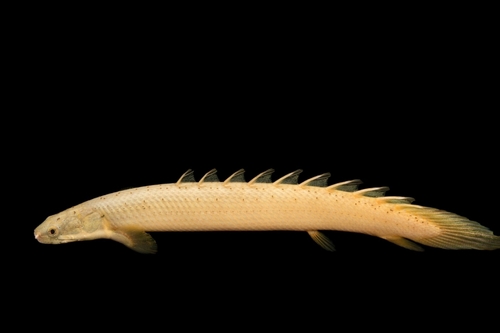If you have the funny-faced, delightful dinosaur bichir as your pet fish, you’ve got a great tank resident. However interesting it may be, though, it is natural to hope to expand your fish collection. If this is the case, you could be wondering: what are the best dinosaur bichir tank companions?
The 12 best tank mates for a dinosaur bichir are fish that are either large or medium in size compared to the dinosaur bichir. The ideal tank mate should also be peaceable in temperament, which spend most of their time at the top or middle of the tank, avoiding the bottom where the dinosaur bichir dwells.
In this article, we will explore our list of the 12 best dinosaur bichir tank mates, as well as information on each type of fish so that you can understand for yourself what makes them so perfect as companions!
Contents
Everything Important to Understand About Dinosaur Bichir Tank Mates
If you want to have a successful community tank, and you begin populating it with the dinosaur bichir, you should be aware of exactly how certain factors can disturb the peace in your aquarium. For example, temperament, size, food competition, and the parameters of your tank all play a part!
Let’s look at how each of these factors relates to your dinosaur bichir so that you can pick out the most suitable tank mates.
Temperament
The temperament of the fish in your tank has everything to do with whether or not you’ll have peace or a frenzied battleground! Dinosaur bichir’s are not kind to most other fish. This does not mean that they will attack out of nowhere, but they can be aggressive if they feel threatened or crowded in any way.
This means that the dinosaur bichir needs tank mates which are either completely peaceful, or, if they also have aggressive tendencies, are around the same size as the bichir to avoid too much harm.
Size
Dinosaur bichirs need enough room to claim a space at the bottom of the tank as their own territory, which even aggressive tank mates can avoid wandering into. If the tank is too small, this will be impossible and lead to infighting.
The bichir needs at least 90 gallons of water in a tank for this to be possible.
A dinosaur bichir is a long fish, growing around 14 inches. Make sure, when picking out fish that will be great tank companions, that none of them are smaller than 6 inches long or they may wind up getting eaten!
Competition
Competition refers to how some fish which eat the same diets and feed at the same time might wind up fighting one another during feeding moments. This can lead to less aggressive fish, or fish that cannot out-compete, starving to death.
To avoid this, choose fish that either eat an entirely different diet than the dinosaur bichir, or simply eat at a different time of day. You can also find fish which are simply capable of holding their own when it comes time to eat!
The dinosaur bichir eats a carnivorous diet. It also eats at night, being a nocturnal variety of fish. Usually their meals consist of feeder fish, bloodworms, shrimp, and other small creatures. Because dinosaur bichirs are bottom-dwellers, picking fish that eat carnivorous diets as well is a fine choice, as long as they feed at the top or middle of the tank.
Parameters ; Tank Setup
Dinosaur Bichirs and their tank mates should each live in similar tank conditions. This means that the pH levels should be between 6.2 and 7.8, while the temperature should be between 74 and 82 degrees Fahrenheit.
The Best Dinosaur Bichir Tank Mates
We’ve done our research and settled on the following fish as perfect tank mates for the dinosaur Bichir!
- Elephant Nose Fish
- Oscar Fish
- Peacock Bass
- Flowerhorn Cichlid
- Clown Loaches
- Pink Convict Cichlid
- Black Ghost Knifefish
- Jack Dempsey Cichlids
- Silver Dollar Fish
- Electric Blue Acara
- Siamese tiger Fish
- Hoplo Catfish
We will take a closer look at the scientific and care-related information you’ll need to know for each of these ideal tank mates below!
You might also like:
- Yellow lab Cichlid Tank Mates
- Electric Yellow Cichlid Tank Mates
- Golden Wonder Killifish Tank Mate
- Firemouth Cichlid Tank Mates
1. Elephant Nose Fish
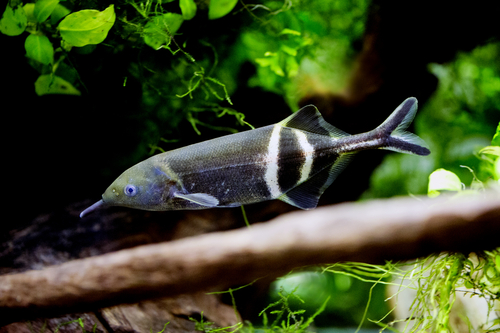
- Scientific Name: Gnathonemus petersi
- Adult Size: 7 to 10 inches
- Compatible With: Bichirs
- Water Temperature: 73 to 82 F
- Minimum Tank Size: 50 gallons
- Care Level: Easy
- Origin: Africa
Although the Elephant Nose fish is slightly smaller than the dinosaur bichir, it will still make a fine companion. Not only does it live in the same tank parameters, but it has enough of a swaggering, semi-aggressive attitude to save it from being intimidated or bothered by dinosaur bichirs.
With that being said, it should not be kept with fish that are small or shy, as it will bully or attack them.
Pros of keeping with Dinosaur Bichir:
- Brave enough to avoid intimidation by dinosaur bichirs.
- Will avoid larger fish, like dinosaur bichirs.
Cons of keeping with Dinosaur Bichir :
- May eat or threaten other smaller fish in the tank.
2. Oscar Fish
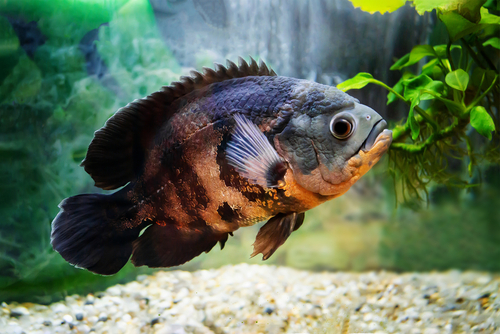
- Scientific Name: Astronotus ocellatus
- Adult Size: 10 to 12 inches
- Compatible With: Bichirs
- Water Temperature: 74 to 81 F
- Minimum Tank Size: 90 gallons
- Care Level: Easy
- Origin: South America
Also called the “Marble Cichlid,” this fish’s mottled warm and dark coloring make it an attractive as well as compatible tank mate with the dinosaur bichir. They are large enough to avoid becoming the dinosaur cichlid’s meal, and a little on the bullying side to avoid intimidation.
However, because the dinosaur chiclid is larger, you’ll have no trouble from the Oscar fish! You may have trouble keeping smaller or more shy fish from the Oscar’s temper tantrums, though.
Pros of keeping with Dinosaur Bichir:
- Will not be bullied by Dinosaur Bichir.
Cons of keeping with Dinosaur Bichir :
- May bully smaller fish.
3. Peacock Bass
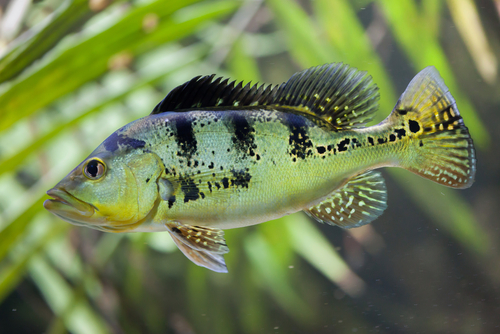
- Scientific Name: Cichla Ocellaris
- Adult Size: 30 inches
- Compatible With: Bichirs
- Water Temperature: 76 to 86
- Minimum Tank Size: 100 gallons
- Care Level: Medium Difficulty
- Origin: South America
The peacock bass is a beautiful fish, and its coloration and difference in shape alone will make it an excellent contrast, visually, to the dinosaur bichir. Truthfully, however, what makes this fish such a compatible creature for the dinosaur bichir is it’s sheer size. No fear of getting eaten or bullied, even if it does happen to wander into bichir territory!
However, you need to make sure that fish which are significantly smaller than the Peacock Bass are not kept in the tank, and it is slightly more difficult to care for such a big fish.
Pros of keeping with Dinosaur Bichir:
- Too big to have any bullying or fighting to fear!
Cons of keeping with Dinosaur Bichir :
- Must be kept in a very large tank.
- Maybully or even eat smaler fish.
4. Flowerhorn Cichlid
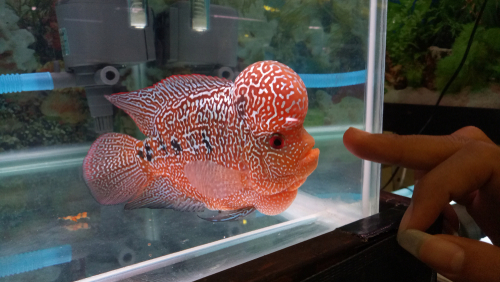
- Scientific Name: Paracheirodon innesi
- Adult Size: 10 to 16 inches
- Compatible With: Bichirs
- Water Temperature: 80 to 89 F
- Minimum Tank Size: 70 gallons
- Care Level: Easy
- Origin: Lab Hybrid
The Flowerhorn Cichlid is certainly an opposite to the dinosaur bichir in looks! With it’s large, bulbous head and range of vibrant colors, you’ll have plenty of visual contrast. This fish is compatible with the dinosaur cichlid because it is moderately aggressive, but will stay away from any fish bigger than itself. Still, most cichlids are aggressive to any other, smaller fish.
Pros of keeping with Dinosaur Bichir:
- Will not pick on a fish so much bigger than itself.
- No feeding competition.
Cons of keeping with Dinosaur Bichir :
- May bully smaller fish.
5. Clown Loaches
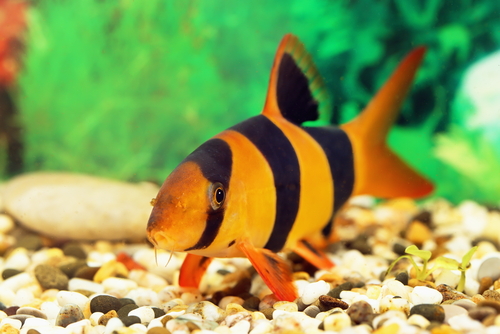
- Scientific Name: Chromobotia Macracanthus
- Adult Size: 7 to 11 inches
- Compatible With: Bichirs
- Water Temperature: 77 to 83 F
- Minimum Tank Size: 100 Gallons
- Care Level: Medium Difficulty
- Origin: Sumatra, Borneo
Clown Loaches are some of the most delightful fish to house in a tank for their playful, social nature and bright coloring. Keep them with other clown loaches, and they will be fine avoiding the territory of the dinosaur bichir and playing tag with one another!
Pros of keeping with Dinosaur Bichir:
- Too fast and peaceful to get into fights.
Cons of keeping with Dinosaur Bichir :
- None!
6. Pink Convict Cichlid
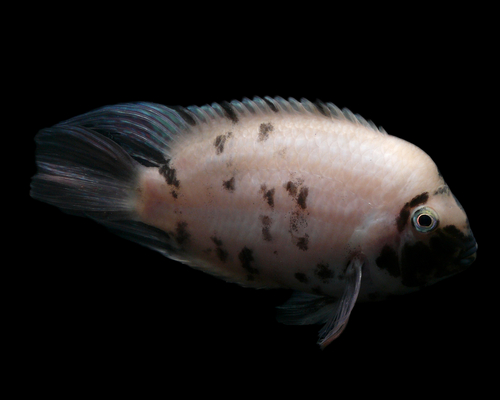
- Scientific Name: Archocentrus nigrofasciatus
- Adult Size: 5.9 inches
- Compatible With: Bichirs
- Water Temperature: 70 to 80 F
- Minimum Tank Size: 10 gallons
- Care Level: Easy
- Origin: Africa
A smaller cichlid, but still aggressive enough to hold it’s own around the larger Dinosaur bichir, the Pink Convict Cichlid is another excellent choice. Make sure to keep it away from smaller tank mates, though.
Pros of keeping with Dinosaur Bichir:
- Alternate feeding schedule will limit food competition between cichlid and bichirs.
- Will not attack larger fish.
Cons of keeping with Dinosaur Bichir :
- May attack smaller fish.
7. Black Ghost Knifefish

- Scientific Name: Apteronotus albifrons
- Adult Size: 20 inches
- Compatible With: Bichirs
- Water Temperature: 73 to 82 F
- Minimum Tank Size: 100 gallons
- Care Level: Easy
- Origin: South America
This fish definitely gets points for having a name as cool as it’s appearance! Being a bit larger than the dinosaur bichir, this is another tank mate you won’t need to worry about getting eaten. It is also semi-aggressive, but is reserved and will only attack smaller fish that invade it’s territory.
It is important to not that if you want to keep both bottom-dwelling fish together, you’ll need lots of plants and places to hide, in addition to plenty of tank space.
Pros of keeping with Dinosaur Bichir:
- Large enough to avoid being bullied.
Cons of keeping with Dinosaur Bichir:
- Without enough tank space, they may fight and compete for food.
8. Jack Dempsey Cichlids

- Scientific Name: Arcocentrus octofasciatum
- Adult Size: 10 inches
- Compatible With: Bichirs
- Water Temperature: 72 to 86 F
- Minimum Tank Size: 50 gallons
- Care Level: Medium Difficulty
- Origin: North America, Central America, Guatemala, Mexico, Yucatan
Named after Jack Dempsey the boxing champion, this fish is appropriately aggressive. However, it is well behaved when kept around large fish like Dinosaur Bichirs. Though they like to swim around the bottom of the tank, they are not technically bottom-dwellers.
As long as there is plenty of room and hiding places, and no smaller fish are kept in the tank, you should have no trouble with your Jack Dempsey Cichlid.
Pros of keeping with Dinosaur Bichir:
- Large enough to avoid being bullied.
Cons of keeping with Dinosaur Bichir :
- Very aggressive toward smaller fish.
- Likely to get into fights without enough cover and space in the tank.
9. Silver Dollar Fish

- Scientific Name: Serrasalmidae
- Adult Size: 6 inches
- Compatible With: Bichirs
- Water Temperature: 75 to 82 F
- Minimum Tank Size: 20 Gallons
- Care Level: Easy
- Origin: Brazil, Guyana
The Silver Dollar Fish may not be as large as the dinosaur cichlid, but it is big enough to avoid getting into trouble with the bottom-dweller. It eats such a wide range of diet that the hardest thing about caring for it is finding a large enough tank; however, if you own a dinosaur bichir, this shouldn’t be too difficult after all.
Pros of keeping with Dinosaur Bichir:
- Large enough to avoid bullying.
- Wide diet means less competition in feeding.
Cons of keeping with Dinosaur Bichir :
- None!
10. Electric Blue Acara
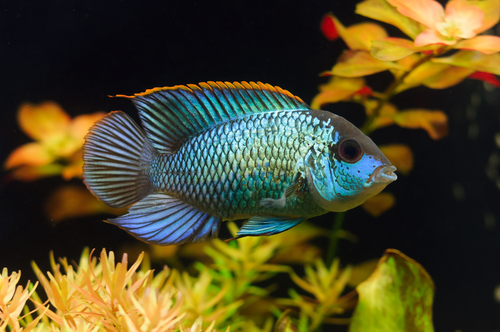
- Scientific Name: Andinoacara pulcher
- Adult Size: 6 to 8 inches
- Compatible With: Bichirs
- Water Temperature: 68 to 82 F
- Minimum Tank Size: 30 gallons
- Care Level: Easy
- Origin: South America, Central America, Trinidad
This cichlid is beautiful, shiny, and colorful! Unlike other cichlids, it is not quite as aggressive around other fish and can take care of itself without outright starting fights. Though it may enjoy digging in the substrate of your tank, it is fast enough to get out of the dinosaur bichir’s way if the bottom-dweller is irritated.
Pros of keeping with Dinosaur Bichir:
- Quick and peaceful enough to avoid fights.
Cons of keeping with Dinosaur Bichir :
- None!
11. Siamese Tiger Fish

- Scientific Name: Datnioides Microlepis
- Adult Size: 17 inches
- Compatible With: Bichirs
- Water Temperature: 72 to 79 F
- Minimum Tank Size: 60 gallons
- Care Level: Medium Difficulty
- Origin: Asia
This fish is large, beautiful, and carnivorous. For these reasons, it should not be kept with fish that are much smaller than itself, but it will work out just fine as a tank mate for the Dinosaur Bichir! Both fish are big enough to avoid more than one or two skirmishes.
Pros of keeping with Dinosaur Bichir:
- Large enough to avoid fights with dinosaur bichir.
Cons of keeping with Dinosaur Bichir :
- None!
12. Hoplo Catfish

- Scientific Name: Megalechis thoracata
- Adult Size: 6 inches
- Compatible With: Bichirs
- Water Temperature: 72 to 86 F
- Minimum Tank Size: 44 gallons
- Care Level: Easy
- Origin: South America
This cute, whiskered fish has a great personality! It is small, but not small enough to become the prey of the dinosaur bichir. They are also covered in spines, another element that keeps them safe from big tank mates. That being said, they are peaceful in nature!
Pros of keeping with Dinosaur Bichir:
- Too peaceful and spiny to risk being eaten.
Cons of keeping with Dinosaur Bichir :
- None!
In Conclusion
To sum it all up, the 12 best Dinosaur Bichir tank mates are fish that are either too large to be eaten, like the Silver Dollar Fish, or fast enough to avoid the territorial Dinosaur bichir’s tantrums, like Clown Loaches. Other fish which make good tank mates simply do not inhabit the bottom zone of the tank!
Altogether, finding good tank mates for your dinosaur bichir is easy as long as you pick large, semi-aggressive to peaceful fish.

Ian Sterling, founder of Fishlab.com, began his aquarium journey over 30 years ago, driven by a deep fascination for fish and their diverse personalities. His website, Fishlab.com, is dedicated to making fishkeeping accessible and enjoyable, offering beginner-friendly guidance, expert insights, and a community for aquarists to connect and share experiences.


